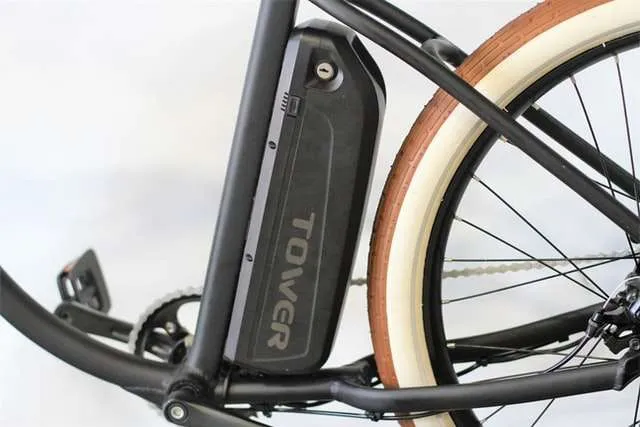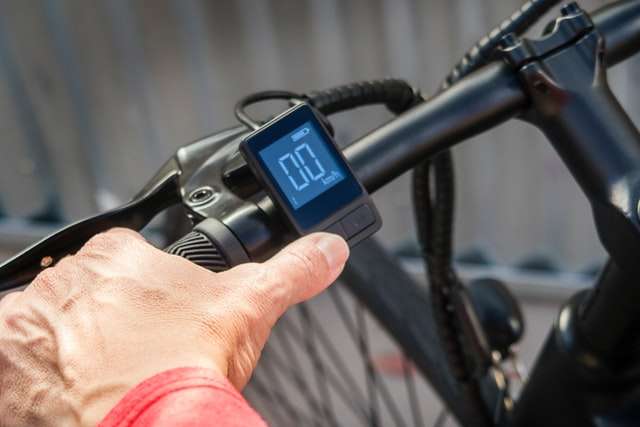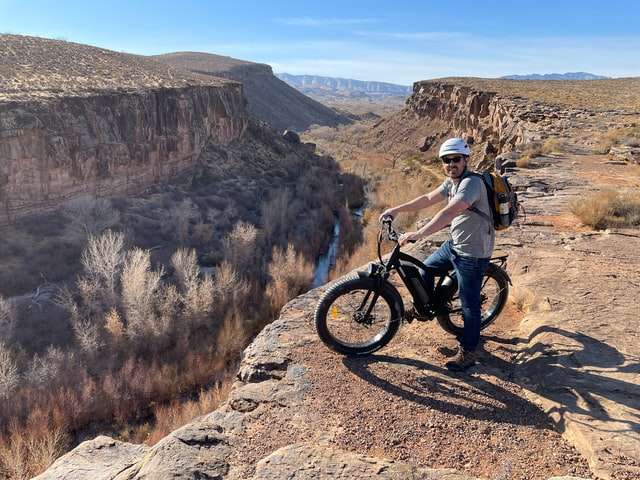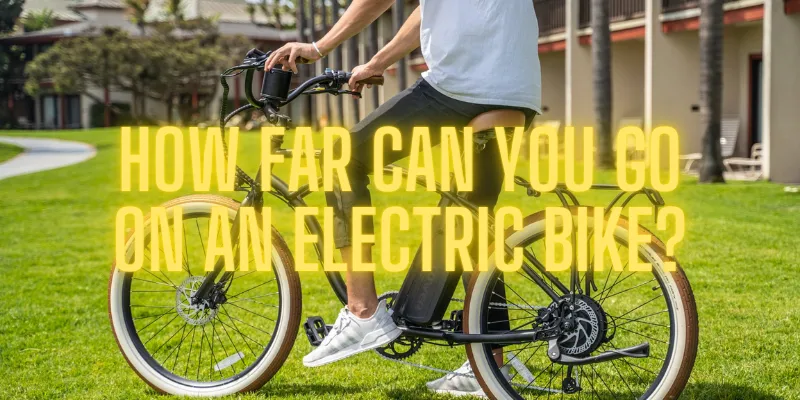People choose electric bikes over regular bikes because they allow you to go further with the same amount of leg power. It now becomes essential to know how far an electric bike can go on a single charge because nobody wants to have to stop frequently to look for places to charge their bike.
How far an electric bike can go on a single charge is what is referred to as the ‘electric bike’s range’. There are so many things that affect the range of an electric bike and we’ll attempt to highlight as many as possible in this article.
How Many Miles Can an Electric Bike Go

This is a question that does not have a simple, definitive answer because various things affect how many miles an electric bike can go before you have to charge it again.
Assuming you want to ride the bike until it’s fully drained (which I wouldn’t advise), a standard electric bike can go anywhere between 25 and 50 miles on a single charge.
You might think that’s a wide range, but as we go into the factors that affect it, you’ll understand why.
Note: A lot of manufacturers claim that their bikes can reach lofty range figures, but they are usually inflated. To get a range closest to what is advertised, it’s important to drop to the lowest pedal assist mode while riding.
Factors Affecting Electric Bike Range
The reason why it’s challenging to determine the actual range of a bike is simply because there are a lot of control variables. Apart from the battery capacity, some real life factors can affect the performance of your eBike and it’s range. Here are some factors to keep in mind when determining your e-bike range:
- Battery Capacity
The capacity of a battery is the amount of energy a battery cell can store. Battery capacity is the most important factor determining the range of an electric bike; the larger the battery capacity, the more energy the bike has, enabling the rider to travel further.
Battery capacity is measured in ampere-hours(Ah), it represents the maximum number of amps that a battery can withstand for one hour, and an amp is the SI unit of electric current.

So, for example, if you have a bike with 20Ah and 24V, that’s 480 watt-hrs. But if you have a bike with 8Ah and 24V, then it has only 192 watt-hrs. This means the first bike can be used for much longer than the second bike with a single charge.
- Riding Style
Frequent stops and starts take a lot out of the e-bike battery energy power, just like it does in cars. If you’re riding in the city with traffic and traffic lights, it’s something that you can’t really avoid.
If the high assistance level (turbo or similar) on the electric bike is turned on when you want to move forward or start the bike, the battery will drain faster.
You should reduce the assistance level to improve the range of your eBike. It may reduce your starting speed, but it will considerably conserve your electric bike battery.
- Weight and Load Capacity
The heavier the rider and bicycle, the lower the electric bike battery range. If you’re carrying heavy cargo or passengers, you will have to increase the assistance level and pedal faster; this will all contribute to draining the battery faster.
For this reason, lightweight bikes can cover a further distance than heavier bikes; essentially, less energy has to be consumed to move the bike forward. So it is advisable to go for lighter bikes and bikes made with lighter material (carbon fiber) if your focus is range.
- Tire
The pressure and texture of the tire are also very important when we talk about the range of an electric bike. A smoother, narrower tires would give less resistance to the bike, which would mean it would require less energy to move and in turn, have more range.
Also, fully inflated tires increase the bicycle’s range because they require less rolling resistance and take less energy from the battery.

- Weather
Certain weather conditions also play their part in determining the range of an electric bike battery. Cycling with a tailwind will increase the e-bike range while cycling against the wind would decrease the range.
Likewise, extreme temperatures are not good for the bike battery; if the battery is exposed to temperatures too hot or too cold, the battery would not be able to store as much energy as in moderate temperatures. Less energy stored translates to lower ebike range.
- Terrain
The type of surface you are riding on has a significant impact on how far you can go on an electric bike. Going up a steep hill takes a lot more effort than riding on a flat surface or going downhill.
A smooth, fast surface will allow a bike to go further on a single charge than a rough, rugged surface.
In addition, if there are many hills on the trip, the total distance covered will be higher than the straight line distance, which has its own effect.
The terrain also determines how often you will have to start and stop, and we’ve discussed what effect that has on the battery of an electric bike.
- Bike assistance mode
Using a high assistance mode drains your ebike’s battery and reduces its range. This also applies to using only the throttle instead of pedal assist. Extended use of throttle rapidly drains power and reduces range.

- Battery Type and Age
An older, worn-out battery performs worse than a new or well-maintained one in terms of range. Also, lithium-ion batteries typically perform better than nickel-cadmium batteries.
Related post: How Long does an eBike Motor last?
How To Estimate Your Ebike’s Range

The first step towards determining the approximate range of your ebike is to check the battery capacity. Usually, battery capacity is measured in watt hours (Wh). Some other batteries show capacity in volts and amp hours. Watts are the result of multiplying voltage and capacity.
Wh = V x Ah or
Watt hours = Voltage x Amp hours
So if your bike’s battery power is measured in volts and amp hours, you can easily convert to Wh by multiplying the volts (V) by the amp hours (Ah). For instance, a 48 volts and 10amp hours battery is a 480Wh battery.
So, if we use Heybike Mars foldable ebike battery as an example: 48V x 12.5 Ah = 600 watt-hours (Wh). This is how you know the watt-hour capacity of your bike battery.
The next step is to calculate your range by dividing the watt hour capacity of the battery by an average efficiency number in Wh/mi or Wh/km.
Now, it has been estimated that the average e-bike travels 1 mile for every 20 Wh of energy consumed. So to figure out your electric bike’s range, you will just have to divide the Wh capacity by 20.
Following our Heybike Mars foldable ebike example, it would be able to travel (600 /20) miles on a single charge, which would equal 30 miles.
Related post: How to ride an electric unicycle
Which E-bike Has The Longest Range?
This is a never-ending debate in the biking community, and it’s not one that we can comprehensively and adequately answer here. We can however provide the facts.

Many electric bicycle manufacturers claim that their e-bikes can go far, but only one can lay claim to having the bike with the longest range. With a Guinness World Record breaking 367 km (228 mi) distance on a single charge, Delfast’s Prime electric bicycle takes the trophy when it comes to long range ebikes.
Here’s a list of some honorable mentions:
It can go up to 300 Miles on a single charge. Fitted with a massive 52V 3.3kWh battery, this bike has not only a long range but a decent amount of torque.
This bike was designed for pleasurable long-range commuting and offers up to 100 miles when in eco mode (lowest power support mode). When in full-powered support mode, the bike offers up to 40 miles, which is impressive.
This bike was designed to spend many miles on the road and is one of the best bikes on the market when it comes to range. It has an impressive 110-mile range (eco mode) and also has very good acceleration.
Suggested post: Electric bike speed limiter removal
If you’re looking for an affordable bike to take long-distance rides, then this is the bike for you. With a 500 Wh battery, this bike offers around 25 miles on a single charge. That’s great value for money for how affordable it is, and that’s why it features on our list today.
- Gyroor C3 14”
This electric bike features a powerful motor and can get up to a speed of 18 mph. It offers up to 38 miles on a single charge, which makes it popular amongst electric bike enthusiasts. In addition, the shock-absorbing tires combined with the shock mitigation system results in a smooth ride.

This off-road accessible e-bike will take you up to 22-40 miles on a single charge, so you can ride on slightly tough terrain. This electric bike has a swappable battery and an easy-to-assemble light aluminum frame.
The Ancheer Sunshine AT1 electric bike is a very good choice for commuters looking for a comfortable long ride.
Whether you’re riding near or far, the 36V 10.4Ah battery makes sure that you’ll see up to 40 miles on a single charge. The robust frame supports up to 300 lbs, and users can enjoy speeds up to 20 mph.
Does More Power = More Range?
Most definitely! The larger your bike’s battery capacity, the longer the range of hours that it can go on one charge. This does not disregard the fact that there are other external factors which invariably affect the riding range of your bike.
But despite these variables, battery capacity is still the most important factor when it comes to e-bike range. While rider weight, terrain, weather condition and the likes are key variables, the real difference in e-bike range comes from its battery capacity.
This is why it’s best to get a good quality battery with as many watts per hour as you can afford if you want to go far on your ebike.
How To Improve Your Ebike’s Range

- Maintain A Steady Speed
I know one of the thrills of riding is going faster and faster but if you’re looking to improve the range of your electric bike, it will benefit you to go easy on the throttle.
Each time you accelerate, you are using considerably more energy than when going at a steady speed; hence the less you accelerate, the better the range is. Occasionally coast!
Instead of going full throttle when you want to accelerate, try to ease into the throttle and accelerate slowly.
By taking less time to get up to speed, you keep the amount of power used by your battery at a minimum.
- Lower The Assistance Level
Pedal-assist electric bikes assist you as you pedal; this level of assistance can be lowered or raised. The higher the assistance level, the faster the battery will drain and reduce the range. So if your goal is the maximum range, then you should ride at a lower assistance level.
- Don’t go too fast
If you aren’t in a rush and aren’t trying to keep up with traffic for safety reasons, try slowing down. Even a slight reduction in speed will significantly decrease the amount of energy you are using to maintain that speed.
Energy use vs speed isn’t linear, so dropping your speed by just 3% is actually saving more than 5% of your energy. In other words, slowing down a couple miles per hour can greatly improve your electric bike’s range.
Related article: How much does an electric bike cost?
- Pump Up Your Tires
Tires that are kept at the optimum air pressure have less rolling resistance, meaning your battery consumes less energy getting you to move.
When your tires aren’t fully pumped, they create a drag, leading to higher battery energy consumption leading to reduced range.
Always make sure you pump your tires so you can get the most out of them; you’ll usually find the required tire pressure on the side of the tire.
- Reduce Your Load When Possible
The heavier the electric bike, the more energy that is consumed when riding. When there is too much load on the bike, it takes more effort to push it forward.
This leads to the battery draining faster and in turn reduces the range of the bike. So if you’re looking to stretch your range, you should leave any unnecessary items at home.
- Carry a Spare Battery or Range Extender
A range extender is a relatively new device that delivers extra reserve energy to e-bikes when they are on the go. The device is shaped like a water bottle and can be mounted on the bike when needed; the additional energy is available to the bike through the charging port.
It can increase the range of some e-bikes by up to 50%, making a huge difference when riding. The LED display on the front surface provides information about the charge level; the range extender is charged through the regular e-bike charger.
Check out this video to see how incredible Bosch’s eBike range extender is:
Some other brands of range extenders are Mahle X35 Range Extender, Priority Battery Extender and Specialized SL Range Extender.
Final Note
In conclusion, it’s important for you to do your due diligence when buying an e-bike. To make the best choice, do not take advertised ranges too seriously.
When using an ebike, you have to deal with several factors like wind, condition of the terrain, total payload, etc. These factors can positively or negatively affect the range of your bike.
So, if a high bike range matters a lot to you, get a bike with good battery capacity. And to get the most efficiency out of your bike, adjust other factors within your control accordingly. Thanks for reading. Cheers!


I use a Pedal-assist (Pedelec) touring bike. I recently completed an eight day, 770km tour with fully loaded paniers. Finished the tour with only using 40% of my 250 watt hour battery, and that on the third day into a 90 minutes of strong head wind. As you said, it all depends.
Wow! That’s incredible! What bike is that?
40 miles@ 14+ mph and 2400′ climbing will use less than 50% of my 250wH battery. So 100 mile range in view and 80 miles for sure. Carbon road bike. But with more climbing or faster speeds range would be less for me.